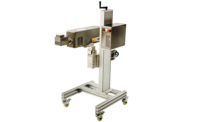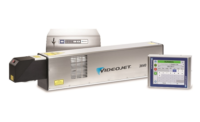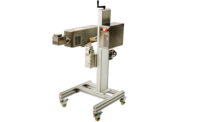Machinery
CPG Manufacturers Turn to Fiber Laser Marking Systems
Advancements in laser marking technology make an enticing option on the packaging line.








For years, fiber lasers have been a mainstay in the electronics, automotive and aerospace markets with their ability to produce crisp, durable alphanumeric text in a range of fonts, logos, 2D codes and bar codes on the surfaces of hard plastic and metal parts. Now, with advancements in speed, ease-of-use and size, fiber lasers are gaining a foothold in consumer packaged goods (CPG) manufacturing.
Laser Versus Continuous Inkjet (CIJ)
CIJ printers continue to be the leading choice for CPG manufacturers to print variable data like batch codes, serial numbers, bar codes and traceability information onto products and packaging. While laser marking solutions, especially fiber lasers, require a much larger upfront investment than CIJ options in both the laser itself and fume extraction equipment, a comparison of fiber lasers to CIJ printers should consider the overall benefits of laser technology.
Foremost is the ongoing savings resulting from a laser’s low maintenance and the lack of inks and solvents that are required for inkjet solutions.
Next, lasers offer a better overall print quality than CIJ printers, whether it’s text, linear bar codes, 2D bar codes, graphics or logos. This is because lasers draw continuous line segments, whereas CIJ prints with ink drops at a lower resolution. The marks made by lasers are permanent — a real benefit for traceability when marked products must withstand repeated exposure to moisture, extreme temperature swings or harsh environments throughout their lifecycle.
All Lasers Are Not the Same
While a viable choice for parts marking and on various coated aluminum, PVC, rubber and metal surfaces, Nd:YAG lasers are not generally appropriate for CPG applications. Fiber lasers offer advantages including higher speeds and greater energy efficiency compared to Nd:YAG and other solid state lasers with higher power. For example, a new Videojet 30 watt fiber laser can run at speeds up to 2,000 characters per second, while its 100 watt predecessor Nd:YAG system could only achieve speeds up to 1,300 characters/second.
In addition to greater speed and energy efficiency, fiber lasers have the advantage of operating without the need for lamp replacements or liquid cooling systems that require routine maintenance. Fiber lasers use a low-maintenance air-cooled Ytterbium (Yb) fiber laser source instead of a gas laser tube or a laser rod, as in Nd:YAG laser markers. Moreover, the absence of lamps and diode pumps means fiber lasers can forgo the pump chamber maintenance needed in high-powered Nd:YAG lasers.
Fiber or CO2?
CO2 lasers offer excellent code quality and easy line integration, and they’re generally less expensive than fiber lasers. So why use a fiber laser instead of CO2? The choice is most often driven by the material being marked.
Whether CO2 or fiber, it is a laser’s wavelength, energy (beam) source and power output level that often determine the quality of the resulting mark. While a beam from a fiber laser passes through most clear glass and clear plastic surfaces without making a readable mark, it can produce an excellent color change on many opaque plastics, foils and metals. Both CO2 and fiber lasers can mark on moving and static products.
Julia Affolder, senior technical instructor for Videojet Technologies, reports that CPG manufacturers with difficult-to-mark surfaces are finding fiber lasers to be the most suitable option. “Fiber lasers are often the ideal solution for marking on bare metal cans, caps and closures, and hard plastic packaging. As with any application, the material should be tested before committing to a marking technology,” says Affolder. “But these high-density surfaces tend to react better to a fiber laser’s beam, producing a color change or engraved mark with excellent readability, and at the production speeds required by many CPG manufacturers.”
Without requiring a liquid cooling system for the arc lamp, a fiber laser’s source life expectancy is much longer — about 100K hours mean time before failure (MTBF) for typical fiber lasers compared to 45K hours for a high-performance CO2 laser. A longer, more stable source life can make up for the difference in cost.
Recent advancements give some fiber lasers even greater flexibility for installation with innovative marking heads and options for network protocols. Affolder says, “New technology makes fiber laser marking an option in many production environments where it wasn’t before. For instance, the new Videojet 7340 and 7440 lasers feature the smallest CIJ-inspired marking head with a flexible umbilical, opening up a myriad of configurations for mounting and integration. And with communication protocols like Ethernet IP, PROFINET, TCP IP and RS232, users can experience greater control, communication and data collection.”
Fiber Laser Technology Innovations
Now with the introduction of IP69-rated marking heads, certain fiber lasers can offer excellent performance on CPG packaging lines in wet, humid and dusty environments.
“IP69-rated marking heads are a game-changer,” says Affolder. “With them, manufacturers often don’t have to bag or remove a fiber laser’s marking head during a washdown. This can mean a faster restart after the cleaning process.” IP69-rated equipment is protected against dust as well as high pressure and high temperature (80˚C) water ingress.
CPG manufacturers have many options for marking codes and other information on their product packaging. In addition to the material being marked, factors such as line speed, throughput, and required mark content and size also dictate the best printing or marking technology. For marking on plastic, metal and foil packaging, CPG manufacturers often choose fiber lasers for their high efficiency, reduced maintenance, easy integration and crisp, durable codes. The right coding partner can help to select the ideal fiber laser with the appropriate power, lens and marking head for a manufacturer’s application.
Looking for a reprint of this article?
From high-res PDFs to custom plaques, order your copy today!










